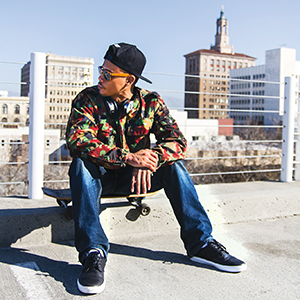Features & Columns
Rey Resurreccion Aims to Break Big
 Rey Resurreccion Photograph by Geoffrey Smith II
Rey Resurreccion Photograph by Geoffrey Smith II
Inside a Milpitas elementary school's multi-purpose room, splashed with swaths of green, blue and yellow, Rey Resurreccion teaches a chess class for youngsters. Fifteen students surround him in a semi-circle, squirming with pent-up energy. Once settled, "Chessmaster Rey," as the kids call him, points to the hanging chess board and explains the gambit: sacrificing a piece for a more advantageous position on the board.
He recounts a game from memory, rattling off each move at a break-neck pace, but the kids stay with him. When he runs into a teachable moment, he asks the students to suggest moves before proceeding.
Condensing a game that might have lasted hours into less than five minutes, there is soon a victor, and before the students break out into individual games, he delivers his key point for the day: "Make sure every move you make counts."
At this point in his career, Rey Res knows well the importance of thinking things through. Arguably San Jose's best-known rapper, he's built considerable buzz since dropping his Sleeping Giants mixtape in collaboration with CLOUT Magazine in late 2010. But he realizes he's reached a crossroads.
Fifteen years into his career as a rapper and he is poised to release Heart of the City, his third full-length LP, on Jan 27, and he hopes this is the move that will grant him a national spotlight.
Building a name in a cutthroat music industry, especially in a genre as saturated as hip-hop, offers little room for error. Breaking out involves love from the blogosphere, commercial placement, iTunes listings, vinyl pressings—in other words, visibility. And every move must count.
"The way I equate my career right now is I feel like I'm the kid that was a high school sports star [who was] really known and respected in my hometown, but now I've graduated and I'm amongst all the other guys that were really good in their hometowns," he explains while sitting in his black Acura Integra one sunny weekday afternoon.
Rey is quick to pad the analogy with some confidence: "I feel like I'm really close."
'The Hometown'
Growing up with divorced parents, Resurreccion (his actual name) spent his weekends on San Jose's south side near Blossom Hill Road at his mom's house. During the week, he lived on Snow Drive in San Jose's Great Oaks neighborhood near Monterey Road at his dad's. He didn't think much of his surroundings back then, but now he realizes how his experiences weren't like those of other locals.
At 8, a good friend mentioned at school that his father had been killed. A gang member who was in and out of jail, he was murdered outside a bar. It was the first time a person Rey knew personally had died.
"You had to grow up fast, because there were a lot of teenagers in the neighborhood that peer-pressured a lot of my friends to go in certain directions," he says. "I was in the middle of all that."
As he notes on "The Hometown," Resurreccion grew up the only Filipino on his street. Other kids would often refer to him as "Chino" when he'd bike by, mistaking him for Chinese.
"I just think they just weren't educated on the other types of Pacific Islanders and Asians that there were," he says.
Many neighborhood friends joined gangs. They rolled deep. They had girls. He saw the allure of that life, but Rey chose to steer clear, thanks in part to his father, who joined a Filipino gang when he first arrived in Daly City. While Rey didn't learn of his father's checkered past until later, it likely played a part in how his father spoke of the dangers of falling into the lifestyle. Rey managed to skirt assimilation while remaining chill with the various sets in his neighborhood.
"I don't know how I did it, but I found a cool balance, to be able to be around them but not join them," he says.


